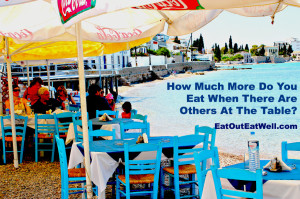You tend to mimic your table companions. They eat fast, you eat fast. They eat a lot, you eat a lot. Ever wonder why you look at some families or couples and they’re both either heavy or slender? As Brian Wansink, PhD says in his book, Mindless Eating, “birds of a feather eat together.”
How Much More Do You Eat When There Are Others At The Table?
Research has shown how strong the tendency is to increase how much you eat when you eat with others. Compared to eating alone you eat, on average:
- 35% more if you eat with one other person
- 75% more with four at the table
- 96% more with a group of seven or more
Why?
Eating more when you’re in larger groups compared to when you eat alone is common for adults. One reason is a phenomenon called “social facilitation,” or actions that are stimulated by the sight and sound of other people doing the same that that you’re doing. When you’re eating in groups, social facilitation helps override your brain’s normal signals of satiety – allowing you to eat more even when you’re not hungry.
Calorie Savers:
- Think about how many people you’re eating with, who they are, and why you’re out to dinner with them. If you want to have a blast and don’t care about how much you eat – eat with a big group and chow down.
- If you want to be careful about what and how much you eat, think about eating lunch with your salad (dressing on the side, please) friends rather than the pepperoni pizza group.
- You tend to adjust your eating pace to that of your companions, so sit next to the slow eaters rather than the speed eaters if you’re trying to control how much goes into your mouth.
This is part of Week 2 of the lose 5 pounds in 5 weeks challenge. How are you doing? Post what you’re doing on Facebook and remember to “Like” EatOutEatWell while you’re there. Follow us on Pinterest and Twitter, too.

